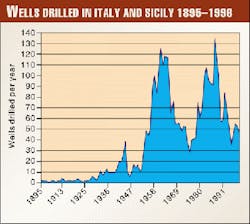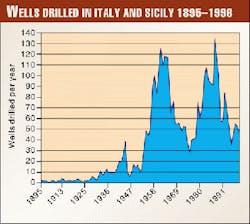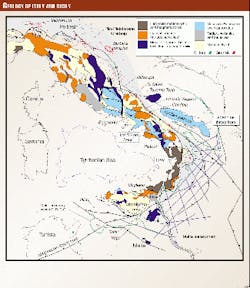Membership in the European Union has necessitated changes in Italian law, opening a number of formerly restricted industries to outside investment and participation. Several recent articles in industry publications1 have highlighted regulatory changes that have opened Italy's gas and power generation industries to participation by foreign companies.
In addition, Italy's dependence on imported oil and natural gas is expected to increase significantly during the next 10 years. Forecasts indicate that the proportion of Italian gas demand satisfied by imports will rise from 66% in 1997 to 90% by 2010. Over the same period, imports will also account for over 90% of the crude oil consumed in Italy.
These changes are expected to result in substantial new opportunities for foreign companies in all aspects of Italy's energy sector.
The increasing need for hydrocarbons has resulted in a more attractive climate for exploration in Italy, especially in areas that remain relatively unexplored. In light of the very large reserves discovered in the lightly explored southern Apennines the past decade (>1.0 billion bbl of oil equivalent recoverable), attention is now concentrated on southern Italy. This three-part article summarizes the petroleum geology of Italy and Sicily and examines the potential of the virgin deepwater areas off the southern coast on the basis of a new regional seismic grid.
Exploration history
The level of hydrocarbon exploration in Italy and Sicily has remained quite modest since the first hydrocarbon exploration well was drilled in 1895. This was especially true through the first 5 decades of exploration.
At the end 1951 the total number of wells that had been drilled in the country stood at only 359. The early part of the 1950s saw a substantial increase in the exploration for hydrocarbons as the Italian economy recovered from the destruction of World War II. The total number of exploration and development wells drilled for hydrocarbons increased from 13 during 1951 to 101 in 1957 (Fig. 1).
However, even with this postwar increase in activity, the total of all wells drilled in Italy and Sicily by the end of 1998 stood at just 3,701. By comparison, despite the current historically low levels of activity, Oil & Gas Journal estimated that operators drilled 23,900 wells in the US during 1998 alone.
A variety of reasons can be cited for the historically low levels of activity in Italy. Most important is undoubtedly the relative complexity of its geology. Due to its location at the margin of several different plate and tectonic regimes, Italy's geology ranks among the most complex and interesting in Europe. However, for the same reasons its structure, stratigraphy, and petroleum potential remain some of the least understood, especially that of the Mesozoic carbonate section of the southern Apennines.
During the 1970s a very limited drilling program resulted in the discovery of a few modest Mesozoic fields in the southern Apennines. Further exploration was curtailed by the poor quality of seismic data in the area, the result of the rough topography and complex, thrusted subsurface geology.
However, improved seismic techniques, including 3D, resulted in the discovery of a major new oil province in the Val D'Agri area of the southern Apennines in 1989. At least four large fields have been discovered in the area so far. Total recoverable reserves for three of the fields (Monte Alpi, Monte Enoch, and Cerro Falcone) are estimated at 600 MMboe. Those for the fourth, Tempa Rossa, are estimated at 420 MMboe.
The discovery of the large Val D'Agri oil fields, in combination with large gas fields discovered previously in southern Italy (Luna field, 1.3 tcf), suggested that the virgin deepwater areas to the south could also hold the potential for large discoveries. It was not until the recent development of deepwater drilling technologies that exploration in those waters was feasible.
In addition, prior to late 1998 seismic coverage in the area south of Italy was limited to a few scattered lines acquired by various organizations for academic purposes. These data were generally of insufficient quality and extent to be useful in evaluation of the hydrocarbon potential of the area. Therefore, in order to provide a regional grid of modern seismic data for evaluation of the deepwater areas, during late 1998 Wavetech Geophysical and Fugro-Geoteam acquired 3,350 km of high-fold, long-offset seismic data (Fig. 2). That data set provides the basis for the ideas presented here.
Current oil, gas demand
Italy is the third largest user of hydrocarbons in Europe, behind only Germany and the UK.
Government statistics for 19972 show that Italian use of natural gas outstripped domestic production by a ratio of almost 3:1. Natural gas consumption for 1997 was 2.045 tcf (57.9 bcm), while domestic production totaled only 688 bcf (19.5 bcm). From 1996-97 gas demand increased by over 3%, while domestic gas production fell by 4%. The disparity between domestic supply and demand was even greater for crude oil. Italy's 1997 oil production of 44 million bbl satisfied less than 10% of demand.
Oil currently accounts for 56% of the energy balance in Italy, with natural gas at 27% and the remainder coal and other fuels. This balance is expected to reverse over the next decade as the majority of Italy's oil-fired power generation facilities are converted to natural gas. By 2010 natural gas consumption is expected to reach 3.18 tcf/year (90 bcm).
General structure and geology
The general structure of southern Italy and Sicily are similar, except in orientation. Tectonic structure is dominated by the north-northeast oriented Apennine thrust system in southern Italy and the roughly east-west trending Maghrebian wrench/thrust system on Sicily.
Each includes four general structural zones. The oldest and highest of these is formed by Hercynian metamorphic and magmatic rocks exposed in extensive nappes of the Calabrian zone of northeastern Sicily and southwestern Calabria (Figs. 2, 3). These rocks overlie an allochthonous sequence of intensely deformed Mesozoic oceanic sediments and obducted ophiolites of the Ligurian nappes. The central portion of each area is dominated by an extensive, allochthonous section of Miocene flysch, deposited in front of and subsequently deformed by the eastward and southward advancing Apennine and Maghrebian thrust fronts.
Immediately east and south of the respective thrust fronts lies a Pliocene-Pleistocene foredeep section of widely variable thickness. Beneath the allochthonous Miocene section lies a thick section of Triassic through Early Miocene platform carbonates. These carbonates are allochthonous in the southern Apennines but are autochthonous on the Hyblean Plateau in southern Sicily and the Apulian platform of southeastern Italy.
Hydrocarbon production has been established in all of the zones except the Calabrian and Ligurian nappes. Mesozoic carbonates are oil productive from thrust stacks of the Val D'Agri play of the south Apennines and autochthonous platforms in southern Sicily. Allochthonous Miocene flysch sandstones produce gas and occasional oil in eastern Italy and central Sicily. Sandstones of the Plio-Pleistocene foredeep section are the major gas reservoirs of the Po basin, Adriatic, and along the Apennine thrust front in east-central Italy.
Structural evolution Mesozoic
The structural evolution of Italy and Sicily is the product of post-Hercynian interactions between the European and African-Arabian continents caused by differential spreading rates in the central and southern Atlantic.
During the Triassic Italy and Sicily lay just south of the Hercynian fold belt on the broad northwest shelf of the Tethys, an area of broad carbonate platforms separated by narrow, deep-marine troughs. The Upper Triassic section includes both extensive shelf carbonate reservoirs and important source rock intervals, including organic rich black shales, marls, and limestones. Several of the large fields of southwestern Sicily produce heavy oil derived from Upper Triassic source rocks and reservoired in Upper Triassic shelf carbonates.
By Middle Jurassic time active spreading along the southern edge of Europe had connected the narrow Alboran, South Penninic-Ligurian, and Dinar-Hellenic troughs with the Tethys, leaving the shelf as a broad promontory (Italo-Dinard) extending north from Africa. Internally, the promontory consisted of three broad carbonate platforms. The Apenninic platform occupied the western third of the promontory, with the Apulian and Karst platforms to the east. The narrow troughs dividing the platforms continued to subside during Jurassic time. Deep marine shale, marl, and limestone were deposited in the deep marine Lagonegro trough between the Apenninic and Apulian platforms, as well as the smaller Molise trough, which lay within the Apulian platform.
During the Late Jurassic and Early Cretaceous, the western and central Mediterranean area underwent a major shift in tectonic regime. Late Jurassic spreading in the Central Atlantic initiated a counterclockwise rotation of Africa with respect to Europe, along with major movements along the Azores-Maghrebian-South Anatolian wrench system. In the central Mediterranean area the net result was a north-northeast convergence of Africa/Arabia with Europe.
By Aptian-Albian time the western portion of the Tethys had disappeared and the northeastern Italo-Dinard promontory was in active collision with Europe along the Alps on the north and Hellenides on the east. Despite the active thrusting along the northeastern margin of the promontory carbonate deposition continued over its western and central parts, persisting into Lower Miocene time in a few areas.
Outcrops of Mesozoic carbonates are extensive in southern Italy and Sicily. Allochthonous Apenninic platform carbonates are exposed along the western side of the peninsula, with allochthonous rocks of the Lagonegro and Molise troughs in the central portion.
Autochthonous carbonates of the Apulian platform are exposed in southeastern Italy, from the Gargano Peninsula through the Apulian platform. On Sicily, carbonate rocks of the Apenninic platform are exposed in several areas along the northwestern coast and on the Hyblean Peninsula to the south.
Eocene-Oligocene
Tectonics in the central Mediterranean region were dominated by the Eocene-Oligocene main phase of Alpine orogeny as the collision of the Italo-Dinard promontory with Europe continued.
Following the Late Oligocene incorporation of the Karst platform, active consumption of the promontory by underthrusting along the Dinarides and Hellenides nappe systems slowed. Concurrently, Apennine thrusting was initiated along the western side of the promontory as it collided with the Corsica/Sardinia block. This fragment of the Hercynian Spanish-French continental margin was rifted away from the continent and rotated southeastward (counterclockwise) during the Oligocene. It collided with the west side of the Apenninic platform in the Late Oligocene, thrusting deep oceanic sediments and ophiolites of the Ligurian nappe eastward onto the platform.
Lower-Middle Miocene
Following the collision of the Corsica/Sardinia block and Apenninic platform convergence was replaced by a period of active back-arc spreading in the southern Tyrrhenian Sea. The Corsica/Sardinia block retreated largely intact but left one fragment permanently accreted to the western edge of Apenninic platform. The Hercynian metamorphic and magmatic rocks of this fragment form the Calabrian nappe of southernmost Italy (Calabria) and northeastern Sicily (Fig. 3).
Thrusting continued in the Apennines throughout the Miocene, producing successive nappes of Ligurian, Apenninic, and Lagonegro rocks. Ahead of the advancing thrust sheets, a thick wedge of Miocene (Numidian) flysch sediments were deposited in the foredeep created in the eastern part of the Lagonegro basin.
Upper Miocene
During Late Miocene time the continuing rotation of Africa-Arabia progressively narrowed the connection of the Mediterranean area with the Tethys. With the eventual collision of the Arabian plate with southern Europe and Spain with Africa at Gibraltar, all connections between the Mediterranean and the open marine waters were severed.
This restriction of marine circulation, coupled with the tectonic highlands that surrounded the Mediterranean, resulted in the deposition of the Messinian evaporite sequence. Thick sections of Messinian evaporites were deposited in the Algero-Provencal, Tyrrhenian, and Ionian-Levantine basins, along with lesser amounts in various local depocenters.
These local depocenters often included "piggyback" basins on the back of the advancing thrust front. Such was the case in southern Sicily, where thick Messinian evaporites have been mined commercially for decades in the Caltanisseta basin. Evaporite deposition ended with a major Early Pliocene transgression and the return of deep waters and normal salinities to the region.
Pliocene and later
Early Pliocene rocks are dominated by deepwater facies, including diatomaceous shales and marls. At the conclusion of Early Pliocene time the Lagonegro and Miocene flysch sections were thrust eastward over the western edge of the Early Pliocene foredeep and the western part of the Apulian platform. Significant thicknesses of Upper Pliocene and Quaternary rocks are largely confined to the resulting foredeep, with only a thin cover in other offshore areas.
Large-scale vertical movements along the margins of the Malta-Hyblean and Apulian platforms probably began during Late Miocene time, with the initial foundering of the central portion of the survey area between the two platforms. Even greater subsidence along the platform bounding normal fault systems was reserved for Late Quaternary time, where the faults underlie the present bathymetric escarpments.
Next: Four geologic settings dominate the oil and gas fields of Italy and Sicily.





